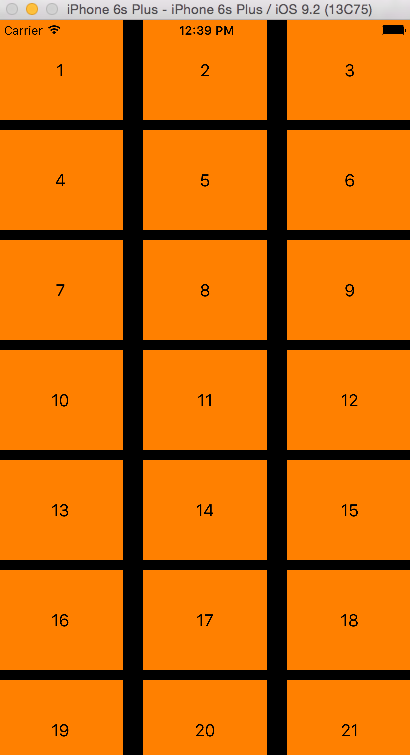IOS 瀑布流UICollectionView实现
在实现瀑布流之前先来看看瀑布流的雏形(此方法的雏形 UICollectionView)
对于UICollectionView我们有几点注意事项
- 它和tableView不一样,ContentView的内容完全需要我们自己去添加。
- 它与tableview相比,他的初始化需要FlowLayout并且大部分操作在其上。
- UIcollectionView的实用性极强,虽然有时他并不是最好的解决方案,但是它可以很灵活的实现各种效果。
图(一)

如图,模拟器上展示的是很多方格,但是值得注意的是他们是有规则的。
虽然看上去很整洁但是并不美观。
我们所说的要实现瀑布流就是要实现它的不整洁,但是规律(这里我说的是规律)
正题
前面说了UIcollectionView的大部分操作在FlowLayout上,当然也包括格局部署。
为了实现瀑布流我们所要实现的便是改变他的格局部署。
在写代码前先确定一下实现思想。
- 需要什么???
- 首先我们需要确定瀑布流的显示风格
- 然后根据确定好的风格进行整体设计
- 最后通过细节的处理完善代码
- 我们需要什么样的风格???
- 我们需要的是实现将上面图片中的布局改变为不等高的效果
- 说的俗一点就是像名字一样,像瀑布流水一样
- 整体该如何设计???
- 整体采用与上面图片一样的设计方法,每个模块都是一个cell
- 确保最上面一行的cell的y值相同(美观)
- 确保不不会出现一列特别长,一列特别短的效果
- 初步细节有哪些???
- 因为每个cell的height不同,所以我们要考虑放置的顺序应该是什么
- 精简代码(这是每个项目必须注意的)
- 我们需要什么样的风格???
实现效果

代码
下面是实现的代码部分(不提供demo了 很简单)
我在注释中简单介绍。
---
//
// ViewController.m
// CX-瀑布流UIcollectionView实现
//
// Created by ma c on 16/4/8.
// Copyright © 2016年 bjsxt. All rights reserved.
//
#import "ViewController.h"
#import "CXCollectionViewCell.h"
#import "CXCollectionViewLayout.h"
static NSString * identifier = @"cellID";
@interface ViewController ()<UICollectionViewDataSource>
//所要展示的UICollectionView
@property (nonatomic, strong) UICollectionView * collectionView;
@end
@implementation ViewController
#pragma mark - <懒加载>
- (UICollectionView *)collectionView {
if (!_collectionView) {
//初始化我们自定义的flowLayout
CXCollectionViewLayout * flowLayout = [[CXCollectionViewLayout alloc]init];
//初始化collectionView
_collectionView = [[UICollectionView alloc]initWithFrame:self.view.bounds collectionViewLayout:flowLayout];
//设置数据源(collectionView的命根子)
_collectionView.dataSource = self;
//注册我们自定义的cell
[_collectionView registerNib:[UINib nibWithNibName:NSStringFromClass([CXCollectionViewCell class]) bundle:nil] forCellWithReuseIdentifier:identifier];
}
return _collectionView;
}
#pragma mark - <life>
- (void)viewDidLoad {
[super viewDidLoad];
//在self.view上添加---
[self.view addSubview:self.collectionView];
}
#pragma mark - <UICollectionViewDataSource>
//这里返回的是item的个数 返回100
- (NSInteger)collectionView:(UICollectionView *)collectionView numberOfItemsInSection:(NSInteger)section{
return 100;
}
//这里返回的是cell 我们可以在这里进行一些简单的操作
-(UICollectionViewCell *)collectionView:(UICollectionView *)collectionView cellForItemAtIndexPath:(NSIndexPath *)indexPath{
CXCollectionViewCell * cell = [collectionView dequeueReusableCellWithReuseIdentifier:identifier forIndexPath:indexPath];
//为了瀑布流的实现细节我们添加的Label
cell.label.text = [NSString stringWithFormat:@"%zd",indexPath.item];
//cell的背景色
cell.backgroundColor = [UIColor orangeColor];
return cell;
}
@end
---
//
// CXCollectionViewLayout.m
// CX-瀑布流UIcollectionView实现
//
// Created by ma c on 16/4/8.
// Copyright © 2016年 bjsxt. All rights reserved.
//
#import "CXCollectionViewLayout.h"
//瀑布流的列数
static NSInteger CXcolumnCount = 3;
//瀑布流的内边距
static UIEdgeInsets CXdefaultEdgeInsets = {20,15,10,15};
//cell的列间距
static NSInteger CXcolumnMagin = 10;
//cell的行间距
static NSInteger CXrowMagin = 10;
@interface CXCollectionViewLayout ()
//存放所有cell 的布局属性
@property (nonatomic, strong) NSMutableArray * CXattrsArray;
//缩放所有列的高度
@property (nonatomic, strong) NSMutableArray * CXcolumnHeights;
@end
@implementation CXCollectionViewLayout
#pragma mark - <懒加载>
- (NSMutableArray *)CXattrsArray{
if (!_CXattrsArray) {
_CXattrsArray = [NSMutableArray array];
}
return _CXattrsArray;
}
- (NSMutableArray *)CXcolumnHeights{
if (!_CXcolumnHeights) {
_CXcolumnHeights = [NSMutableArray array];
}
return _CXcolumnHeights;
}
#pragma mark - <准备布局>
//准备布局(布局前自动执行)
- (void) prepareLayout{
//重写此方法一定要记得super
[super prepareLayout];
//在实际操作中我们的数据并不会固定不变的,因此我们每次布局前最好要清空之前存储的属性
//清空存放所有列的高度
//清空存放所有cell的不去属性
[self.CXcolumnHeights removeAllObjects];
[self.CXattrsArray removeAllObjects];
//首先为第一行的cell附高度
for (NSInteger i = 0; i < CXcolumnCount; i ++) {
//数组里只能存放对象
[self.CXcolumnHeights addObject:@(CXdefaultEdgeInsets.top)];
}
//下面开始创建每一个cell的布局属性 并且添加到存储cell布局属性的数组中
//cell总个数 因为这里只要一个section
NSInteger count = [self.collectionView numberOfItemsInSection:0];
for (NSInteger i = 0; i < count; i ++) {
// 创建位置 即indexPath
NSIndexPath * indexPath = [NSIndexPath indexPathForItem:i inSection:0];
//获取indexPath对应的cell布局属性
UICollectionViewLayoutAttributes * attributes = [self layoutAttributesForItemAtIndexPath:indexPath];
//把获取到的布局属性添加到数组中
[self.CXattrsArray addObject:attributes];
}
//准备布局的工作到这里就结束了
}
//返回所有cell布局属性 及整体cell 的排布
- (NSArray<UICollectionViewLayoutAttributes *> *)layoutAttributesForElementsInRect:(CGRect)rect{
return self.CXattrsArray;
}
//返回cell 的布局属性
- (UICollectionViewLayoutAttributes *)layoutAttributesForItemAtIndexPath:(NSIndexPath *)indexPath{
//创建布局属性
UICollectionViewLayoutAttributes * CXattributes = [UICollectionViewLayoutAttributes layoutAttributesForCellWithIndexPath:indexPath];
//获取collectionView 的宽
CGFloat collectionViewWidth = self.collectionView.frame.size.width;
//下面的一部分是获取cell的frame(布局属性)
CGFloat width;
CGFloat height;
CGFloat X;
CGFloat Y;
//获取width
width = (collectionViewWidth - CXdefaultEdgeInsets.left - CXdefaultEdgeInsets.right - (CXcolumnCount - 1) * CXcolumnMagin) / CXcolumnCount;
//获取height
//在实际开发中heigh并不是真正的随机 而是根据数据来决定height 在这里展示初步的介绍其原理 因此采用大于100小于150的随机数
height = 100 + arc4random_uniform(50);
//获取X (瀑布流的实现重点就在cell的X,Y值获取)
//设置一个列数的中间变量
NSInteger tempColumn = 0;
//设置高度小的中间变量 在这里我们把第0列的高度给他,这样可以减少循环次数,提高效率
CGFloat minColumnHeight = [self.CXcolumnHeights[0] doubleValue];
for (NSInteger i = 1; i < CXcolumnCount; i ++) {
if (minColumnHeight > [self.CXcolumnHeights[i] doubleValue]) {
minColumnHeight = [self.CXcolumnHeights[i] doubleValue];
tempColumn = i;
}
}
X = CXdefaultEdgeInsets.left + (width + CXcolumnMagin) * tempColumn;
//获取Y
Y = minColumnHeight;
if (Y != CXdefaultEdgeInsets.top) {
Y += CXrowMagin;
}
//设置cell的frame
CXattributes.frame = CGRectMake(X, Y, width, height);
//更新高度最矮的那列的高度
self.CXcolumnHeights[tempColumn] = @(CGRectGetMaxY(CXattributes.frame));
return CXattributes;
}
//返回collegeView的Content的大小
- (CGSize)collectionViewContentSize{
//虽说返回的是大小,但是我们这里主要的是height
CGFloat maxColumnHeight = [self.CXcolumnHeights[0] doubleValue];
for (NSInteger i = 1; i < CXcolumnCount; i++) {
CGFloat columnHeight = [self.CXcolumnHeights[i] doubleValue];
if (maxColumnHeight < columnHeight) {
maxColumnHeight = columnHeight;
}
}
return CGSizeMake(0, maxColumnHeight + CXdefaultEdgeInsets.bottom);
}
@end
到此为止瀑布流的实现也就结束了。
在这里说明几点值得注意的地方。
- 瀑布流中的cell排布顺势是根据当前列的高度有关的(例如:如果当前第三列是最短的,但是按正常情况下cell应该排在第一列,那么这个时候,新的cell会排在第三列,这是为了避免某一列高度特别长或某一列的高度特别短)
- 在实际应用中通常cell的大小是根据数据的来处理的
- UIcollectionView的content的高度是不确定的,因此我们要根据内容设定高度。
- 当涉及到刷新的时候我们要注意cell的布局属性是否在新数据到来前清空了。
